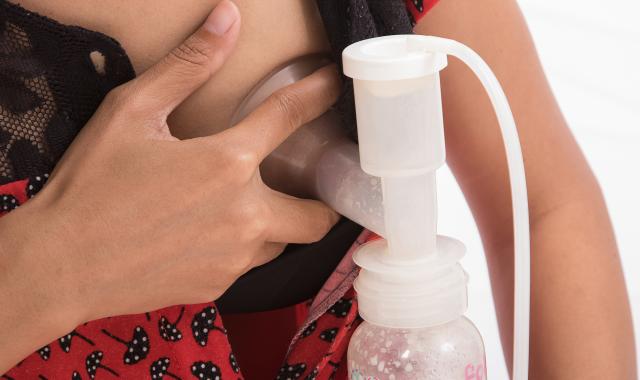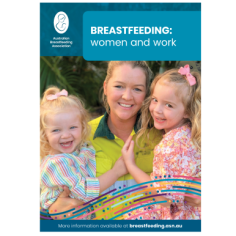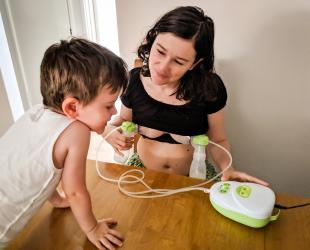Returning to work while breastfeeding?
Many mothers successfully combine a return to work or study with continued breastfeeding. Like most things, a little planning goes a long way.




Commonly asked questions about returning to work and breastfeeding
In short, the confidence and belief that you can do it! With the right planning, information and support, combining breastfeeding with work is easily achievable.
Being prepared and organised can make the transition to your return to work smoother and having a supportive workplace can make a significant difference.
You can start your preparation for returning to work right now. Read more about making a Breastfeeding and Work Plan.
All states have legislation that protects your right to combine breastfeeding and paid work. Under both the Federal and all State legislation it is unlawful to treat a woman less favourably because she is breastfeeding or to treat a person less favourably based on their status as a parent.
This means it may be against the law for an employer to refuse to make arrangements to assist an employee to breastfeed at work or accommodate an employee’s breastfeeding needs (including expressing).
Read more about equal opportunity and workplace diversity.
Australian employers are not legally obliged to provide lactation breaks to their employees, however the International Labor Organization (ILO) recommends that breastfeeding women be entitled to at least one break per day for lactation, and that can also be accessed as a reduction in hours. The ILO further recommends that these breaks should be treated as paid working time.
Many Australian employers are recognising that the needs of a breastfeeding employee are short lived, and that providing lactation breaks is a simple way to support them. While lactation breaks are becoming more common, access to breaks and breastfeeding support is still being negotiated on an individual basis in many non-accredited workplaces.
Read more about approaching your employer to discuss your return to work needs.
It is generally against the law to refuse to make arrangements to assist you to breastfeed at work, if these are reasonable. For example, it may be discrimination if:
- your employer does not provide you with suitable facilities for breastfeeding or expressing milk
- you are not allowed to organise your work breaks to facilitate breastfeeding or expressing milk
- you are told that you must wean your baby before you can return to work.
Some workplaces have a dedicated room for expressing or breastfeeding. Other alternatives can include sharing along with a First Aid room or a prayer room. An unused office or meeting room area are also alternatives.
Your needs as a breastfeeding mother to feed and/or express your milk are small and generally short-lived so most workplaces should be able to come up with something suitable. Read more about approaching your employer.
All mums returning to work are concerned about the practicalities of making it work. Successful pumping at work is all about having a private space, having adequate time to express and having a good quality breast pump. Read more about what you'll need for expressing in your workplace.
Read in more detail about effective expressing, using a breast pump, storing your expressed breastmilk and cleaning expressing equipment.
The climate and the length of your travel from work to home will influence your requirements for transporting your breastmilk. Freshly expressed breastmilk is safe for use for 6 to 8 hours when stored below room temperature (<26 degrees C) or for 72 hours when stored in the refrigerator. In the cooler months or if you only live a short distance from your workplace you may not need to take any special measures. Just remove your expressed breastmilk from workplace fridge on your departure and place in your home fridge or freezer when you arrive home.
When the temperature rises or for those who have a longer commute, you may need to use a small cooler with freezer bricks or similar in it to keep your milk cool during transport. Read more
Breastfeeding Friendly Workplace (BFW) accreditation is awarded by ABA to organisations that provide 3 simple criteria to support their breastfeeding employees: Space, Time and Support. Together these three elements demonstrate to new and existing employees that their workplace and employer is supportive of their potential needs as a breastfeeding employee. Read more about these requirements and how you can approach your employer.
When you discuss your plans for returning to work, you can direct your employer or HR personnel to the Breastfeeding Friendly Workplace pages. There they will find the information and resources they need to put in place to demonstrate their support for you as you return to work.
They can start the process of becoming an employer of choice as an accredited Breastfeeding Friendly Workplace.
7 Tips to Make Returning to Work After Maternity Leave a Bit Easier
Mums deserve support as they transition back to work after maternity leave.

Stories from working mums
"Before going on maternity leave in 2013 I approached my employer, as small not-for-profit organisation, about a flexible return to work. They were happy to negotiate an approach that worked for both of us which was a relief as I have three young children to juggle. Read more
"I returned to work when my son was 5 months old. I invested in a quality electric breast pump and combined expressing and going to feed him in my lunch break. It was tricky but I found people were very understanding and encouraging. Sometimes, it was incredibly tiring, but I knew it wasn't going to be forever and it was worth the hard work. Read more
"I looked into returning to work when I was offered a part time position. It was a bit of a spontaneous decision and I was lucky enough to grab a childcare spot about 5 minutes from work. Read more
Find out more about continuing to breastfeed as you return to work

Evidence-led info and practical tips from our Breastfeeding Information Series
Breastfeeding: women and work


Hire a breast pump

National Breastfeeding Helpline

Local support network
